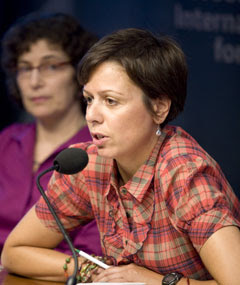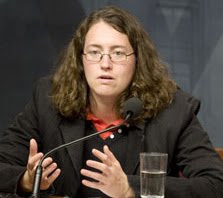Showing posts by Sajid Anwar.
-
Oli Brown on Climate Security and Environmental Peacebuilding
›January 28, 2010 // By Sajid Anwar“Climate change seems to be eclipsing all other environment and security issues, but those issues haven’t gone away,” says Oli Brown, program manager at the International Institute for Sustainable Development (IISD). “There are still problems with illegal timber, still problems with mining, there are still problems with diamonds, there are still problems over land, water, and so on. Climate change encompasses a lot of those issues and makes some of them more difficult and more pressing.”
IISD is working with the United Nations Environment Programme on ensuring that these issues are addressed in UN peacekeeping missions. “What we do with UNEP is to coordinate a group of experts that help to advise the UN family on ways that it should do conflict prevention, post conflict reconstruction, peacekeeping, peace negotiations and peacebuilding more effectively,” says Brown. -
Alec Crawford on Climate Change and Conflict in Africa and the Middle East
›January 14, 2010 // By Sajid Anwar“Climate change certainly does pose a risk to the world in terms of violent conflict, but there’s a lot of nuance to that argument and a lot of attention and care has to be put into making that case,” says Alec Crawford, project officer at the International Institute for Sustainable Development (IISD) in this video interview with ECSP Director Geoff Dabelko.
According to Crawford, the argument that climate change will lead directly to violent conflict is overly simplistic, but climate could be one of conflict’s many drivers in both Africa and the Middle East. A recent IISD report discusses the potential security challenges of climate change and how to prevent them. -
Hot and Cold Wars: Climate, Conflict, and Cooperation
›November 23, 2009 // By Sajid Anwar At an American University event on his new book, Climate Change and Armed Conflict: Hot and Cold Wars, the Center for Teaching Excellence’s James Lee identified some plausible scenarios that the international community will have to face to adequately and peacefully address the security impacts of climate change.
At an American University event on his new book, Climate Change and Armed Conflict: Hot and Cold Wars, the Center for Teaching Excellence’s James Lee identified some plausible scenarios that the international community will have to face to adequately and peacefully address the security impacts of climate change.
With the loss of glaciers and normal river flows, international boundaries that have long been determined by these natural barriers will be called into question, Lee said, raising legitimate issues of sovereignty, migration, and land rights. How will countries separated by large glaciers or rivers deal with their more open and easily accessible borders? Will people who depend on these resources migrate into other countries in search of water? How will these changes impact countries that share these resources?
In his presentation, Lee argued that climate change will lead to violent conflict, using the historical record of climate change and conflict to prove his point. But most of the cases cited occurred before the 20th century, and the changes in climate then were much different than what we are now facing.
Today, we live in a world that is truly global in both governance and accountability. Issues such as severe environmental degradation or scarcity can be a factor in conflict within a country, but the potential for climate change to cause an international conflict is not as high as some warn.
There are multiple variables on the causal chain between climate change and conflict that can be addressed now, through national efforts and international cooperation. Countries can start with strong governance initiatives now to ensure that future problems of transboundary water scarcity, migration trends, and border changes do not lead to conflict.
For example, while climate change may lead to water scarcity, declines in agricultural production, and therefore to food insecurity, countries can avoid this outcome by leasing agricultural land in countries that won’t face high levels of water stress.
In addition, countries could avoid future disagreements over territory by negotiating a shared understanding of borders independent of geographic markers such as rivers or glaciers. These and other variables can be addressed now in order to mitigate the risk of future conflicts.
Renegotiating Water, Avoiding Conflict
Uppsala University Professor Ashok Swain, who spoke via Skype, took a different tack than Lee, stating that the links between climate change and conflict lack proper research. He was concerned by the hard security linkages being made with climate change and called for further exploration.
But Swain identified one potential trouble spot: While interactions over shared river systems have been shown to be overwhelmingly cooperative rather than violent, he voiced concern that the changes brought by climate change are not encompassed in the scope of current water-sharing agreements, which could increase the likelihood of conflict, according to Swain.
In the same way that leasing agricultural abroad or negotiating a shared understanding of borders now could help mitigate conflict in the future, so could renegotiating and strengthening current water-sharing agreements to reflect the future effects of climate change.
Cooperation to ensure sustainable access to shared water sources will still be more likely than conflict, simply because it is more cost-effective. If, as Lee writes in his book, climate change will cause a society’s accumulated wealth to decline, then the cost of mitigating the negative effects of climate change by using force to secure a resource would be too high for any nation to pursue.
Photo: Cracked earth, from the lack of water and baked from the heat of the sun, forms a pattern in the Nature Reserve of Popenguine, Senegal. Courtesy United Nations. -
UNEP’s David Jensen on Linking Environment, Conflict, and Peace in the United Nations
›November 16, 2009 // By Sajid AnwarAt the United Nations, “we see more and more interest in looking at natural resources: how do they contribute to a conflict, and how can they contribute to peacebuilding,” says David Jensen of the UN Environment Programme’s Post-Conflict and Disaster Management Branch in a video interview with ECSP Director Geoff Dabelko.
For example, UNEP experts travel to the UN Peacebuilding Commission’s target countries to examine how natural resources may have contributed to conflict and what role they could play in restoring peace, explains Jensen: “A new module was approved on environment and natural resources. So it’s now integrated within the overall UN post-conflict assessment framework,” which is used by the UN, World Bank, and the European Commission.
Currently, “there are tremendous opportunities,” Jensen says, for environmental security to become a mainstream issue within the United Nations, as exemplified by the Secretary-General’s report, Climate change and its possible security implications. -
Today: International Day for Preventing the Exploitation of the Environment in War and Armed Conflict
›November 6, 2009 // By Sajid Anwar“There can be no durable peace if the natural resources that sustain livelihoods are damaged or destroyed,” said UN Secretary-General Ban Ki-moon, in his message today, the 9th annual International Day for Preventing the Exploitation of the Environment in War and Armed Conflict. He called for “Member States to clarify and expand international law on environmental protection in times of war.”
Coinciding with this year’s observance, the United Nations Environment Programme, along with the Environmental Law Institute, released “Protecting the Environment During Armed Conflict: An Inventory and Analysis of International Law,” which finds serious gaps and weaknesses in international law and offers 12 recommendations for the UN and policymakers.
“Destroying and damaging the natural assets and ecological infrastructure of a country or community should be an issue of highest humanitarian concern,” said UNEP Executive Director Achim Steiner in a UNEP press release.
Earlier this year, Steiner spoke at the Wilson Center to launch From Conflict to Peacebuilding: The Role of Natural Resources and the Environment. In a recent ECSP video interview, UNEP’s David Jensen spoke about how post-conflict resource management can be a platform for economic recovery and cooperation. -
VIDEO: David Jensen on UNEP and Natural Resource Management After Conflict
›November 5, 2009 // By Sajid Anwar“We don’t do the gloom-and-doom scenarios anymore,” says David Jensen of the UN Environment Programme’s Post-Conflict and Disaster Management Branch, in a video interview with ECSP Director Geoff Dabelko. “We focus on the opportunities provided by resource management. We focus much more on how they can support economic recovery, how they support livelihoods, how environment can be a platform for cooperation.”
When conducting its post-conflict environmental assessments, UNEP looks for “entry points using specific hotspots or specific sites that people can really understand and see the linkage between environment and conflict, or between their livelihoods and natural resources,” says Jensen. “We always try to be in the field and demonstrate the value of better resource management” for post-conflict recovery. -
Reporting From Kenya: U.S. Editors Cover Health, Environment, and Security
›November 4, 2009 // By Sajid Anwar The global recession has “been very hard on journalists,” explained Andrea Crossan, radio producer for BBC’s “The World”. “With these kinds of cutbacks, you really feel it when it comes to foreign coverage.” Along with Stephanie Hanson, associate director and coordinating editor of CFR.org, and Margaret McElligott, senior producer for washingtonpost.com, Crossan spoke about the International Reporting Project’s (IRP) Gatekeeper trip to Kenya at a Wilson Center event sponsored by the Environmental Change and Security Program.
The global recession has “been very hard on journalists,” explained Andrea Crossan, radio producer for BBC’s “The World”. “With these kinds of cutbacks, you really feel it when it comes to foreign coverage.” Along with Stephanie Hanson, associate director and coordinating editor of CFR.org, and Margaret McElligott, senior producer for washingtonpost.com, Crossan spoke about the International Reporting Project’s (IRP) Gatekeeper trip to Kenya at a Wilson Center event sponsored by the Environmental Change and Security Program.
“You’ve seen a lot of areas of the world that just aren’t getting the coverage these places deserve, and Africa is one of those places,” said Crossan, partly due to the expense of travel, security, and satellite equipment. IRP, a project of The Johns Hopkins University’s School of Advanced International Studies, aims to fill gaps in foreign reporting left by extensive budget cuts by offering U.S.-based editors and journalists opportunities to report on international stories.
“I’ve traveled a fair amount with the BBC, and I’ve seen some really difficult living conditions for people. I’ve never seen anything like I’ve seen in Kibera,” said Crossan. “We can look at all of the things we are talking about today”—environment, health, security—“through what’s happening in Kibera.”
Poverty and Pirates
At a meeting at the University of Nairobi, a student criticized foreign reporting of Kenya, saying that it “only seems to cover poverty and pirates,” said Crossan. That’s a slight improvement over previous years, when U.S. coverage focused on “witches and war,” noted an audience member.
McElligott, who previously worked for AllAfrica.com, agreed that U.S. media coverage of Africa is becoming richer, with fewer instances of racism accompanying reporting. “The world is so much smaller now,” with email, Facebook, blogs, and video providing additional venues and in-country contacts, she said.
The Kenyan press is the “most trusted institution” in the country, said Hanson. They expose corruption, report on health issues, and call the government to task. With the decline in U.S. journalists posted abroad, the support and stories provided by Kenyan reporters is crucial to getting coverage in the international media.
While pitching international stories to U.S. audiences might be a hard sell, “if it’s a good, compelling story, it will go up in a prominent place” with or without a U.S. angle, said McElligott. “It’s just about telling human stories,” said Crossan.
Kenya on the Edge: Drought and Conflict “In the last months we’ve seen the food crisis grow in Kenya,” said McElligott. On the group’s visit to Laikipia, she noted the impacts of soil degradation, unsustainable water extraction from rivers, and the lack of governmental regulation. Lack of land and water is forcing pastoralists to travel miles away from home in order to feed cattle and goats.
“In the last months we’ve seen the food crisis grow in Kenya,” said McElligott. On the group’s visit to Laikipia, she noted the impacts of soil degradation, unsustainable water extraction from rivers, and the lack of governmental regulation. Lack of land and water is forcing pastoralists to travel miles away from home in order to feed cattle and goats.
“We’re desperate for water here,” said Laikipia resident Niyok Npanyaki in an IRP video report. “We’ve decided that if water is cut off, we’ll go to the water source on Mount Kenya, even if the government doesn’t let us. Otherwise we will die. People don’t start wars for no reason. If I am hungry, but if you have food, I’ll come to you and find it.”
“Loss of natural resources puts people under extreme pressure and people will go to extreme lengths in order to get those fundamentally important natural resources,” says Dr. Anthony King, director of Laikipia Wildlife Forum, in the video. Adding to the tension between farmers and pastoralists is the easy access to firearms in the Horn of Africa. “Almost every pastoralist will have an automatic weapon,” says King.
The IRP fellows visited the headquarters of the UN Environment Programme in Nairobi, but found it difficult to gauge the effectiveness of UNEP at addressing Kenya’s drought and deforestation. According to Crossan, UNEP has invested in a number of local programs, but the UNEP officials they spoke with seemed frustrated that the Kenyan government was not more involved in tackling the country’s environmental problems.
“Something I struggle with in my own work is trying to understand what actual effect these large multilateral agencies have on the ground. What is the World Bank actually doing in Ghana? What are they actually doing in Kenya?” said Hanson. “Does the money get distributed? Who does it go to? Having more Kenyans or Ghanaians who could report on these things and look into them in terms of transparency and accountability would be incredibly helpful.”
Malaria: A Disease of the Poor “Malaria was, to be honest, not a disease that was really on my radar,” said Hanson. “I had, in a way, discounted its importance to what has happened on the continent.” At a children’s critical care unit in Nyanza Province, one of the poorest areas in Kenya with one of the highest rates of HIV and malaria, she saw beds filled with sick children. “This was shocking to me.”
“Malaria was, to be honest, not a disease that was really on my radar,” said Hanson. “I had, in a way, discounted its importance to what has happened on the continent.” At a children’s critical care unit in Nyanza Province, one of the poorest areas in Kenya with one of the highest rates of HIV and malaria, she saw beds filled with sick children. “This was shocking to me.”
When a family member is stricken with malaria, the burden of care is typically falls upon the mother, who often must travel long distances to the nearest hospital—“some of them had walked hours with a sick child,” said Hanson—leaving their other children at home and farms largely untended.
“When these women have to leave their farms to come to the clinic, they’re losing work days on the farm,” said Hanson. “That just means that their farms are less productive. They have less money to send their children to school, give their children medical care, and feed their children.”
“These macro-political issues—disputed elections, post-election violence—are actually connected to daily issues like malaria infections, hospital capacity rates, agricultural yields, and without a government that can address those things it is very difficult to see how a place like Kenya can move forward,” concluded Hanson.
Drafted by Sajid Anwar and Meaghan Parker.
Edited by Meaghan Parker.



 The global recession has “been very hard on journalists,” explained
The global recession has “been very hard on journalists,” explained  “In the last months we’ve seen the food crisis grow in Kenya,” said McElligott. On the group’s visit to Laikipia, she noted the impacts of soil degradation, unsustainable water extraction from rivers, and the lack of governmental regulation. Lack of land and water is forcing pastoralists to travel miles away from home in order to feed cattle and goats.
“In the last months we’ve seen the food crisis grow in Kenya,” said McElligott. On the group’s visit to Laikipia, she noted the impacts of soil degradation, unsustainable water extraction from rivers, and the lack of governmental regulation. Lack of land and water is forcing pastoralists to travel miles away from home in order to feed cattle and goats. “Malaria was, to be honest, not a disease that was really on my radar,” said Hanson. “I had, in a way, discounted its importance to what has happened on the continent.” At a
“Malaria was, to be honest, not a disease that was really on my radar,” said Hanson. “I had, in a way, discounted its importance to what has happened on the continent.” At a 

